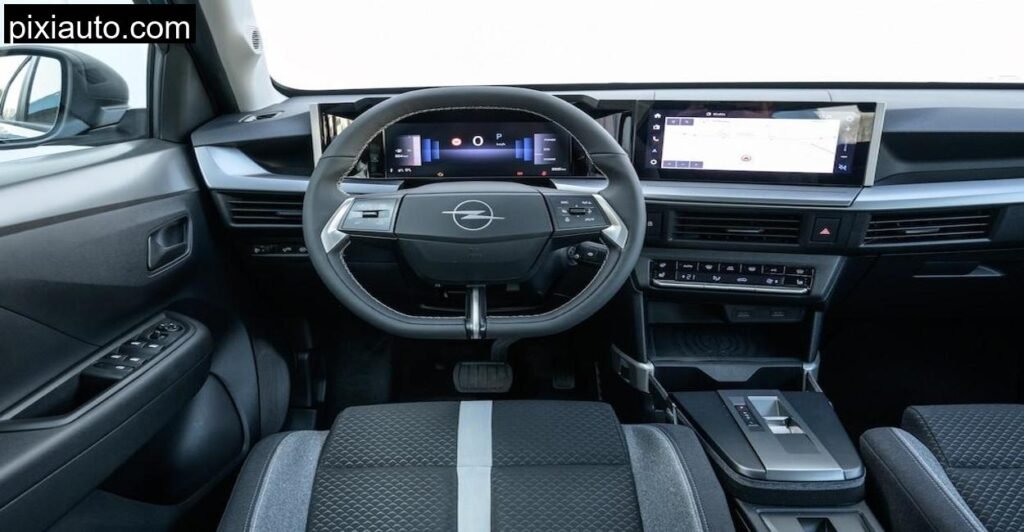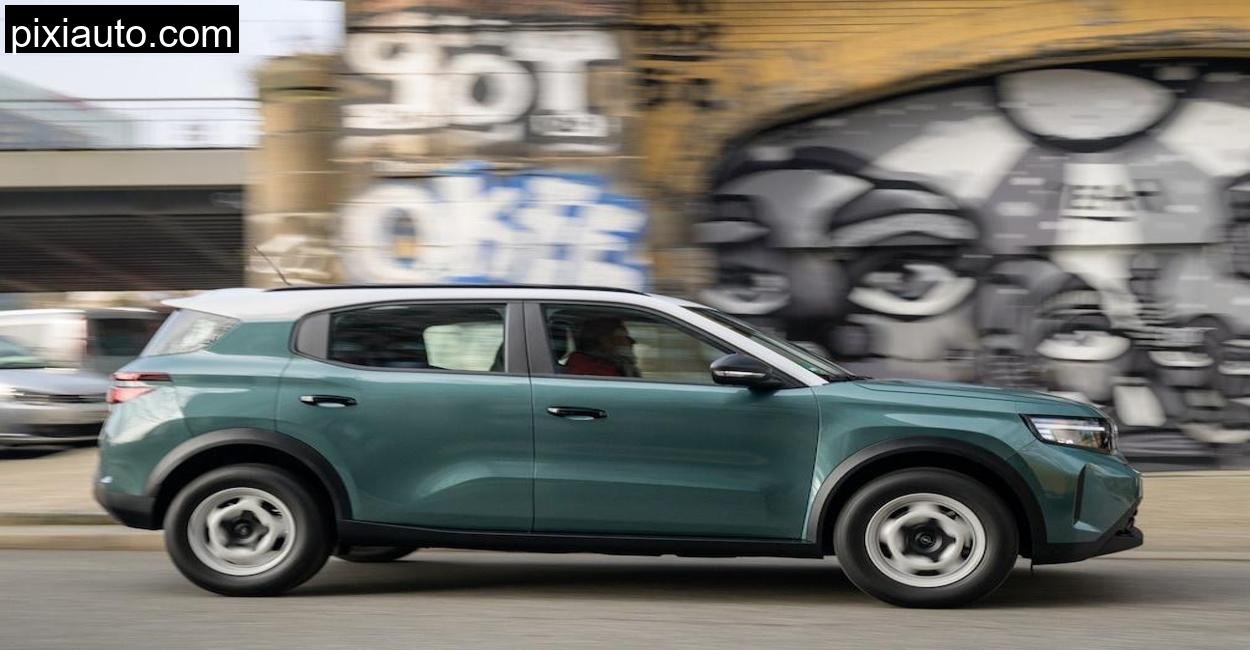If you told me a few years ago that Opel would return with a fresh Frontera, a name with roots in rugged off, road charm, but do it in a thoroughly modern, sensible, and even slightly cheeky way, I’d have raised an eyebrow. But here I was, steering the brand, new Opel Frontera 1.2 DI Turbo 48V through the winding forest corridors of Kellerwald, with its dappled light, humid trails, and crests that reveal views stretching deep into the Hessen highlands.
It’s not a place you’d normally associate with a budget, friendly hybrid crossover. But that’s precisely why we chose it. Kellerwald doesn’t pamper you. If a car can be at home here, among gravel switchbacks, rain, soaked forest tracks, and surprise climbs, it deserves respect. And the Frontera? Let’s just say this baby Opel isn’t afraid to roll up its sleeves.
First Impressions and Design: Tall, Honest, Clever

I stepped up into the Frontera, not slid down into it. That alone tells you something. It’s upright, square, jawed, and proud of it. Opel has thrown aside the fashion, driven sleekness of many crossovers and given us something honest, practicality in design. With steep pillars, a tall stance, and clean lines, this car looks like it was designed by someone who actually drives on unpaved roads and needs usable space.
And then you get inside. There’s a calmness to the interior. It doesn’t try too hard. The center console is uncluttered, the materials are durable but not cheap, and clever touches, like elastic bands for holding gear or a cavernous storage space beneath the boot floor, make it clear that Opel’s playing a different game. There’s no digital gimmickry overload. You want climate control? It’s a physical button. Lane assist annoying you? One touch and it’s off. It’s all refreshingly straightforward.
Engine and Powertrain: Punchy Enough, Perfectly Sensible
Let’s talk numbers before feelings. For trusted accuracy, all technical info is taken directly from the official Opel website.
| Specification | Detail |
| Engine Type | 1.2L 3, cylinder Turbo, 48V Mild Hybrid |
| Power Output | 136 hp @ 5500 rpm |
| Torque | 230 Nm @ 1750 rpm |
| Transmission | 6, speed Dual Clutch (eDCT) |
| Drive | Front, Wheel Drive |
| Top Speed | 194 km/h |
| 0, 100 km/h | ~10.0 seconds (measured) |
| Fuel Economy (Test Avg.) | 6.4 l/100 km |
| CO₂ Emissions | 119 g/km |
| Fuel Tank | 44 liters |
| Boot Space | 460, 1600 liters |
| Trailer Load (Braked) | 1250 kg |
| Roof Load | 240 kg stationary / 65 kg dynamic |
| Base Price | €25,700 |
| Test Car Price | €27,700 |
| Tyres | Goodyear EfficientGrip 2 SUV 215/65 R16 |
Now, here’s the subjective truth: the Frontera doesn’t explode off the line, but it isn’t sluggish either. In Kellerwald, I had the chance to floor it out of tight bends, and the response was composed. The 136 horses do their job steadily, helped by that 48V mild, hybrid system that assists during start, up and low, speed transitions. In fact, in town, you’ll often glide off on battery alone, eerily quiet until the three, pot comes in with a mellow thrum.
The six, speed dual, clutch transmission doesn’t hunt or hesitate much. It’s not sporty, but it’s intuitive. On hill climbs, like the ascent to the Kellerwald Tower path, it stayed confidently in the meat of the torque band. The steering is light, maybe too light at higher speeds, but for city maneuvers or tight rural roads, it’s spot on.
Ride, Comfort and Handling: Effortless All, Rounder
This is where I was most surprised. The Frontera rides better than many cars twice the price. On the old cobbled lanes leading into Kellerwald’s southern gate, it soaked up imperfections with a maturity I didn’t expect. There’s some body roll, sure, this isn’t a performance SUV, but there’s a softness that’s genuinely comfortable without being sloppy.
Handling is relaxed. I wouldn’t call it engaging, but it’s extremely predictable. The wide track, 1552 mm at the front and 1559 mm at the rear, gives it stability, especially in sweeping bends. I threw it around a particularly challenging S, bend leading to an old logging trail, expecting some drama, but it gripped and composed itself immediately. The Goodyear EfficientGrip tyres held their own, and braking was strong without any sponginess.
On wet gravel, I’d have liked all, wheel drive, but the front, wheel system and traction control handled things respectably. Just don’t expect to go rock, crawling.
Interior Usability and Practicality: Smart Storage, Real Space

This is where the Frontera proves it’s not just another badge, engineered crossover. At under 4.4 meters in length, it doesn’t shout “big family hauler.” But inside? It’s a masterclass in space optimization.
The rear seats offered surprisingly generous knee room. I’m 6’1″, and I had inches to spare sitting behind my own driving position. The boot, at 460 liters (and up to 1600 with seats folded), easily swallowed a mountain bike with the front wheel removed. And unlike most SUVs in this price range, it didn’t feel like I was playing Tetris to make it fit.
The roof rails also deserve praise. Rated at 240 kg static load, I could actually fit a full rooftop tent for a camping trip, something you usually reserve for larger SUVs. And the trunk floor’s under, compartment? Deep enough for wet gear, shoes, or even a small toolbox.
Tech and Controls: No Frills, No Fuss
There’s no enormous touchscreen spanning the dash. No self, driving beta. And guess what? That’s a good thing.
The infotainment system in the base model is deliberately simple. No built, in navigation, but connect your smartphone and you’re good to go. Climate? Real buttons. Drive modes? Nope, you just drive. Opel has made a car that doesn’t ask for a learning curve. My drive through Kellerwald didn’t once require me to look away from the road to decipher an icon or submenu.
I particularly liked the dedicated toggle for disabling driver aids. With most cars forcing you to dig through menus just to mute a lane, keep beep, the Frontera keeps it transparent and user, controlled.
Real, World Fuel Economy: Hybrid that Actually Saves Fuel
Over the 185 km I clocked in and around the Kellerwald region, through hill climbs, mixed gravel, city traffic in Bad Wildungen, and highway cruising, I saw a real, world average of 5.8 liters/100 km. On a downhill stretch coasting back to Edersee, I even managed a stint where it hovered just over 4.8.
That’s phenomenal for a petrol, powered crossover. Opel’s decision to go mild, hybrid rather than full, hybrid or electric seems spot on for the target audience, keep the price low, the system simple, and the consumption down.
Conclusion: The Frontera is a Return to Honest Motoring
It isn’t flashy. It doesn’t drift. It doesn’t pretend to be a sports SUV or a luxurious land yacht. What the Opel Frontera does is simple, it shows up, does everything you ask, and never overcomplicates the relationship between driver and machine.
In Kellerwald, where cars either work with the terrain or struggle to keep pace, the Frontera felt at home. It never demanded attention but earned respect with every smooth gear change, every well, placed storage cubby, and every cent it saved at the pump.
This is a car for people who value function over flair, honest engineering over gimmicks. In a world where cars are increasingly bloated with tech and complexity, the Opel Frontera feels like a breath of fresh forest air.
Is the Opel Frontera good for long trips?
Absolutely. Comfortable seats, efficient fuel economy, and ample cargo space make it ideal for weekend getaways or long highway drives.
How does Opel Frontera compare to Dacia Duster or similar rivals?
It’s more refined than a Duster, with better materials and a smarter driving experience. It’s not as rugged but more efficient and civilized.
Will there be a full EV version of Opel Frontera?
Yes, Opel has confirmed an electric Frontera is in the pipeline. But for now, the 1.2 Turbo 48V hybrid offers a great middle ground for those not ready to go full electric.



Leave a Comment